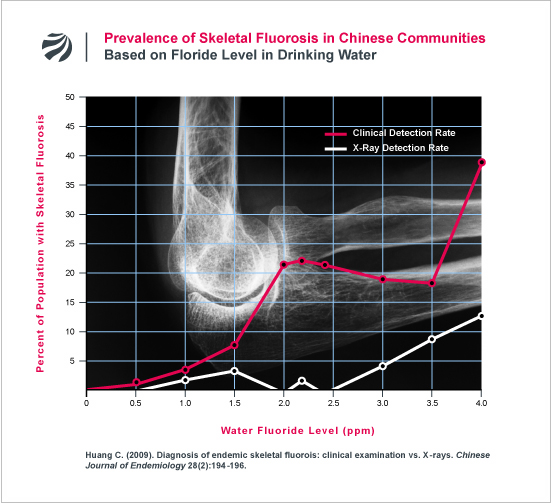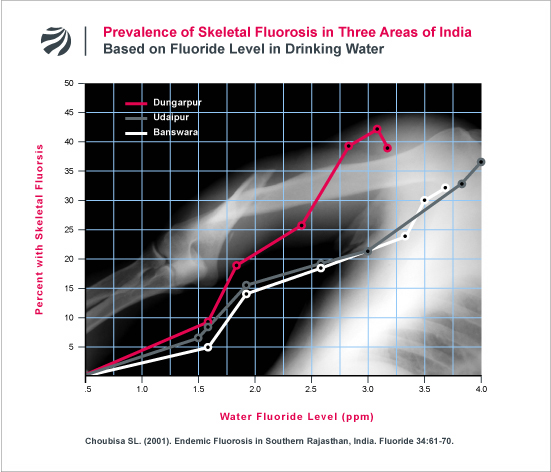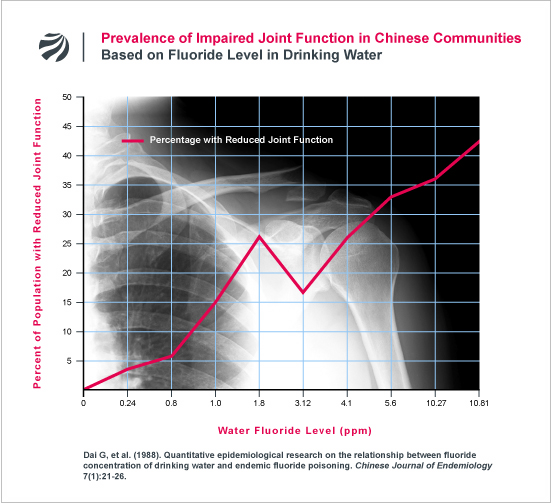Figures: Bone
The Dose That Causes Clinical Skeletal Fluorosis:
In the United States, the Institute of Medicine (IOM) states that anyone over 8 years of age — irrespective of their health condition — can safely ingest 10 milligrams of fluoride every day of their lives without developing symptomatic skeletal fluorosis. Ten milligrams, however, is the same dose that the IOM concedes can cause radiologically detectable skeletal fluorosis (i.e., fluorosis that appears on x-ray) within just 10 years of exposure. On its face, a dose that can cause radiological fluorosis in just 10 years can hardly be considered a safe lifetime dose, particularly since radiological, and even pre-radiological, fluorosis are not asymptomatic (i.e., research shows they can cause chronic joint pain, and even overt osteoarthritis).
Another problem with the IOM’s 10 mg/day standard is that data from China (represented in the following figure) shows that radiologically detectable skeletal fluorosis can occur at doses well below 10 mg/day. According to this study, which was the result of a coordinated effort among many Chinese scientists, radiological fluorosis (i.e., Stage 1 skeletal fluorosis) was repeatedly found among people with average fluoride doses of just 6.5 mg/day. To read FAN’s translation of this study, click here.
The Water Fluoride Levels that Cause Skeletal Fluorosis in China & India
As highlighted by the following two figures, research from China and India has repeatedly found that skeletal fluorosis occurs at water fluoride levels deemed “safe” (< 4 ppm) and even “optimal” (0.7-1.2 ppm) in the United States.
A) Huang (2009)
The following data from China demonstrates two important points: First, skeletal fluorosis is found in communities with less than 1 ppm fluoride in the water. Second, many people who are diagnosed as having skeletal fluorosis (based on their clinical symptoms) do not have skeletal fluorosis that is radiologically detectable by x-ray. This latter point is a critically important one because U.S. health authorities have long relied exclusively on x-rays for diagnosing skeletal fluorosis. As the following data demonstrates, a focus on radiological fluorosis will fail to detect, and protect, many people with skeletal fluoride poisoning.
- To read FAN’s translation of Huang’s study, click here
- To read China’s criteria for “clinical” and “x-ray” fluorosis that was used in this study, click here.
B) Choubisa (2001)
The following data presents the skeletal fluorosis rate (based on clinical symptoms) in three areas of Southern Rajasthan, India. The lowest average fluoride level in the three areas was 1.5 ppm and 1.6 ppm. In the three areas with these levels of fluoride, the skeletal fluorosis rate was found to range between 5 and 10 percent of the population.
- To see the full text of this study, click here.
Arthritic Symptoms Based on Fluoride Level in Water
The following data presents the relationship between the fluoride level in drinking water and the prevalence of joint problems in China. The data further highlights the need for safety standards to shift from their current narrow focusing on radiological evidence of fluorosis to a (far more meaningful) focus on the joint pathologies that can occur with and without radiological fluorosis.
Ge (2006)
- To see FAN’s translation of this study, click here.
Dai (1988)
- To see FAN’s translation of this study, click here





